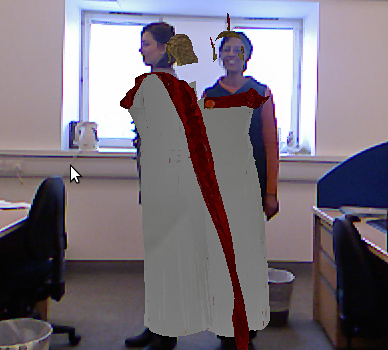Experience ancient cultures—with help from Kinect
To movie lovers, the image of the late John Belushi cavorting around the Delta Tau Chi fraternity house in a toga is comedy gold. But while the period costuming was played for laughs in Animal House, the recreation of virtual Roman attire is serious business to researchers Erkan Bostanci, Nadia Kanwal, and Adrian Clark, who are using Kinect for Windows to create augmented reality (AR) experiences that immerse participants in the cultural heritage of the ancient world. Their system not only recreates virtual representations of ancient Roman architecture, but it also virtually dresses participants in togas and Roman helmets, and even equips them with a virtual Roman sword.
Like previous AR endeavors, theirs combines real-world imagery with computer-generated virtual content. But instead of creating mythical worlds of fantastical beasts, the researchers hope to apply their system (currently in the prototype stage) to recreate archeological treasures at the very sites of the ancient remains, thus allowing visitors to experience to the wonders of antiquity with minimal disturbance to the real-world artifacts.

As shown here in a laboratory demonstration, the AR system recognizes flat surfaces and augments them
with the virtual recreations of architectural features.
Their AR system uses the Kinect sensor’s color and depth cameras to determine the camera’s position and then to find and virtually augment flat surfaces in the real world in real time. So, for example, the system recognizes rectangular shapes as columns and augments them accordingly. This differs from earlier systems that attempt to augment realty by overlaying synthetic objects on camera images, a process that requires an offline phase to create a map of the environment. The Kinect-enabled system thus eliminates the need for programming a graphics processing unit, which makes it attractive for use with lower-power and mobile computers.

By using the Kinect sensor's body tracking capabilities, the system virtually
clothes participants in Roman togas and helmets.
But what really captured our imagination was the use of the Kinect sensor’s body tracking capabilities to virtually clothe participants in historically correct garb. As the researchers note, by augmenting the appearance of the participants, the system deepens their immersion into the ancient culture. The prototype system uses Kinect tracking data of a participant’s head, torso, and right hand to virtually superimpose a Roman helmet, toga, and a sword. After all, if you’re strolling around an AR recreation of the Roman Forum, your immersion in the virtual world can be ruined by the sight of your fellow explorers in cargo shorts and t-shirts.
The Kinect for Windows Team
Key links